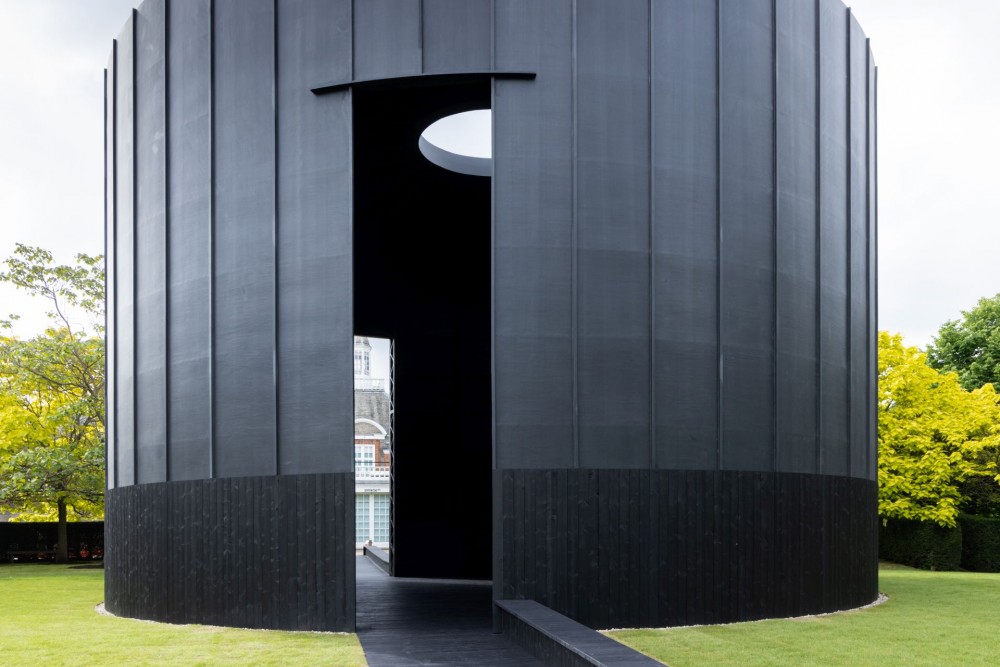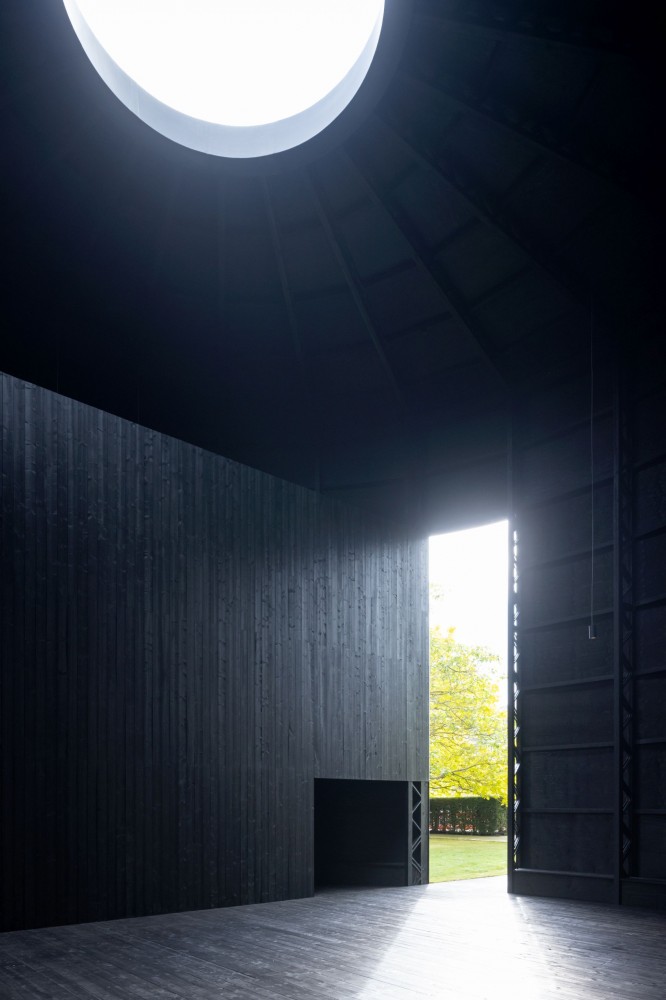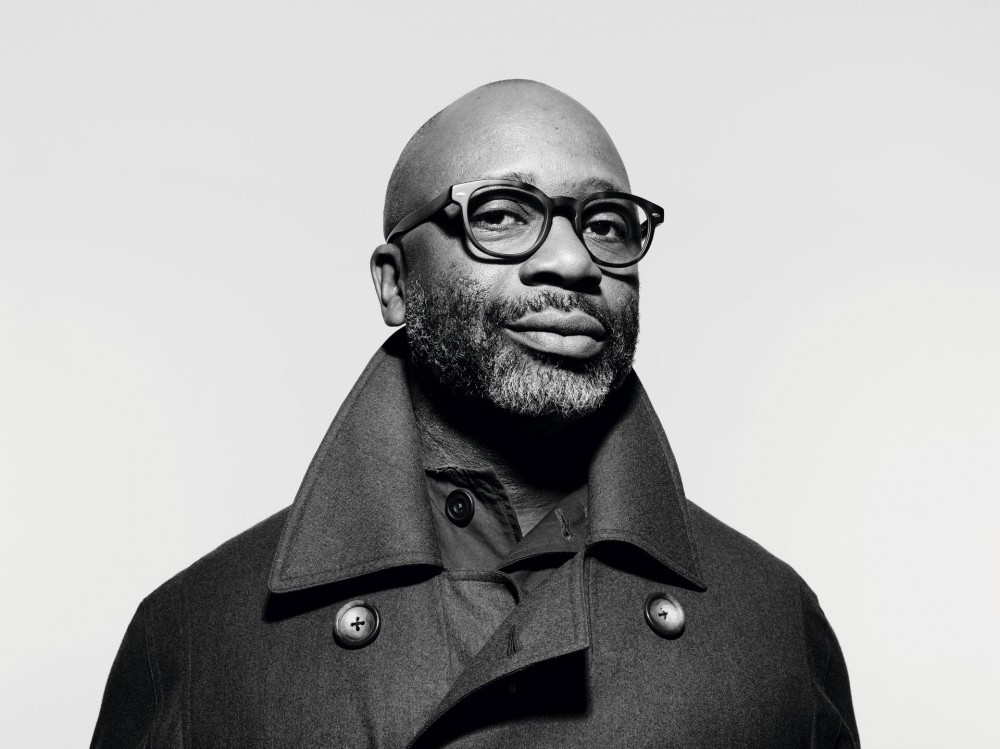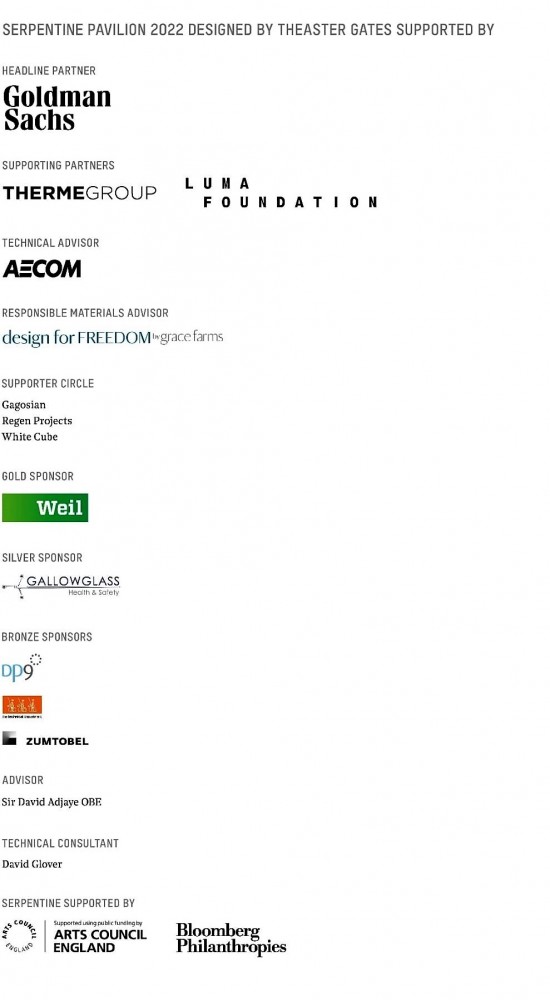
Serpentine Pavilion 2022 designed by Theaster Gates © Theaster Gates Studio. Photo: Iwan Baan. Courtesy: Serpentine.
Black Chapel draws inspiration from many of the architectural typologies that ground the artist’s practice. The structure references the bottle kilns of Stoke-on-Trent in England, the beehive kilns of the Western United States, San Pietro and the Roman tempiettos and traditional African building structures such as the Musgum mud huts of Cameroon and the Kasabi Tombs of Kampala, Uganda.
Drawn to the transcendental environment of the Rothko Chapel in Houston, Texas, Gates has produced a series of new tar paintings especially for Black Chapel. Determined to create a space that reflects the artist’s hand and sensibilities, seven panels hang from the interior structure. In these works, Gates honours his father’s craft as a roofer and uses roofing strategies and torch down, which requires an open flame to heat the material and affix it to the surface.

Serpentine Pavilion 2022 designed by Theaster Gates © Theaster Gates Studio. Photo: Iwan Baan. Courtesy: Serpentine.
An operating bronze bell, salvaged from St. Laurence, a landmark Catholic Church that once stood in Chicago’s South Side, stands next to the entrance of the Pavilion. Underscoring the erasure of spaces for convening and spiritual communion in urban communities, the historic bell acts as a call to assembly, congregation and contemplation throughout the summer’s events.
Theaster Gates said: “The name Black Chapel is important because it reflects the invisible parts of my artistic practice. It acknowledges the role that sacred music and the sacred arts have had on my practice, and the collective quality of these emotional and communal initiatives. Black Chapel also suggests that in these times there could be a space where one could rest from the pressures of the day and spend time in quietude. I have always wanted to build spaces that consider the power of sound and music as a healing mechanism and emotive force that allows people to enter a space of deep reflection and deep participation.”
Gates’ Serpentine Pavilion 2022: Black Chapel follows The Question of Clay, a multi-institution project featuring exhibitions at Whitechapel Gallery (September 2021 – January 2022), White Cube (September – October 2021) and a two-year long research project at the V&A.

Theaster Gates. © Rankin Photography.
Theaster Gates (b. 1973) creates works that engage with space theory, land development, sculpture and performance. Drawing on his interest and training in urban planning and preservation, the artist redeems spaces that have been left behind. His work contends with the notion of Black space as a formal exercise, one defined by collective desire, artistic agency and the tactics of a pragmatist.
In 2010, Gates created the Rebuild Foundation, a non-profit platform for art, cultural development and neighbourhood transformation that supports artists and strengthens communities through free arts programming and innovative cultural amenities on Chicago’s South Side.
Gates has exhibited and performed at The Victoria and Albert Museum (2021), London, UK; Whitechapel Gallery (2013 and 2021), London, UK; Tate Liverpool, UK (2020); Haus der Kunst, Munich (2020); Walker Art Center, Minneapolis (2019); Palais de Tokyo Paris, France (2019); Sprengel Museum Hannover, Germany (2018); Kunstmuseum Basel, Switzerland (2018); National Gallery of Art, Washington D.C., USA (2017); Art Gallery of Ontario, Canada (2016); Fondazione Prada, Milan, Italy (2016); Punta della Dogana, Venice, Italy (2013) and dOCUMENTA (13), Kassel, Germany (2012).
Gates is the twelfth recipient of the Frederick Kiesler Prize for Architecture and the Arts (2021). In 2020, Gates received the Crystal Award for his leadership in creating sustainable communities. He was the winner of the Artes Mundi 6 Prize and a recipient of the Légion d'Honneur in 2017. He was awarded the Nasher Prize for Sculpture 2018, as well as the Urban Land Institute’s J.C. Nichols Prize for Visionaries in Urban Development. Gates is a professor at the University of Chicago in the Department of Visual Arts and serves as the Senior Advisor for Cultural Innovation and Advisor to the Dean at the Harris School of Public Policy. Gates is currently included in A Movement in Every Direction: Legacies of the Great Migration at the Mississippi Museum of Art, Jackson, Mississippi from April 9 – September 11, 2022; and in STILL ALIVE, featured at Aichi Triennale, Tokoname, Japan from July 30 – October 10, 2022.
Serpentine Pavilion
This pioneering commission, which began in 2000 with Zaha Hadid, has presented the first UK structures by some of the biggest names in international architecture. In recent years it has grown into a highly anticipated showcase for emerging talents, from last year’s Sumayya Vally, Counterspace (South Africa), the youngest architect to be commissioned, and Frida Escobedo (Mexico), to Diébédo Francis Kéré (Burkina Faso) and Bjarke Ingels (Denmark), whose 2016 Pavilion was the most visited architectural and design exhibition in the world. The Serpentine Pavilion 2022 follows previous commissions by Olafur Eliasson with Kjetil Thorsen, 2006, and Ai Weiwei with Herzog & de Meuron, 2012, among other cultural figures.
Black Chapel will be designed to minimise its carbon footprint and environmental impact, in line with Serpentine’s sustainability policy. The predominantly timber structure will be light-weight and fully demountable, with a focus on sustainably sourced materials and the reusability of the structure as a whole after its time installed at Serpentine. While the Pavilion begins its life in Kensington Gardens, it will be re-sited to a permanent location in the future.
In 2021, the Pavilion programme evolved beyond its physical location for the first time and expanded with a series of Fragments placed across London. It also saw the launch of Support Structures for Support Structures, a fellowship programme initiated by Sumayya Vally, Counterspace, and Serpentine’s Civic Team, that supports up to ten artists and collectives working at the intersection of art, spatial politics and community practice.


